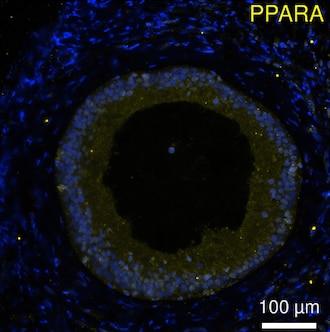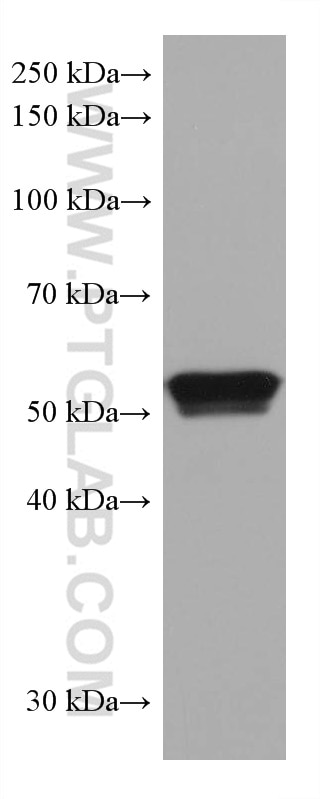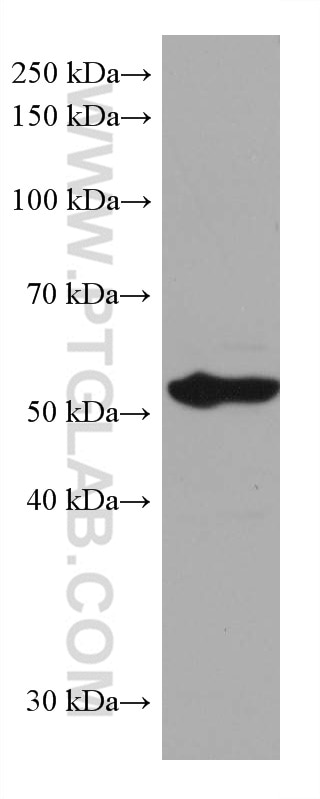Tested Applications
| Positive WB detected in | HSC-T6 cells, ROS1728 cells |
Recommended dilution
| Application | Dilution |
|---|---|
| Western Blot (WB) | WB : 1:1000-1:6000 |
| It is recommended that this reagent should be titrated in each testing system to obtain optimal results. | |
| Sample-dependent, Check data in validation data gallery. | |
Published Applications
| KD/KO | See 2 publications below |
| WB | See 125 publications below |
| IHC | See 14 publications below |
| IF | See 8 publications below |
| CoIP | See 2 publications below |
| ChIP | See 1 publications below |
Product Information
66826-1-Ig targets PPARA in WB, IHC, IF, CoIP, ChIP, ELISA applications and shows reactivity with Human, rat samples.
| Tested Reactivity | Human, rat |
| Cited Reactivity | human, mouse, rat, pig, chicken, zebrafish, hamster, goat |
| Host / Isotype | Mouse / IgG1 |
| Class | Monoclonal |
| Type | Antibody |
| Immunogen |
CatNo: Ag7896 Product name: Recombinant human PPARA protein Source: e coli.-derived, PGEX-4T Tag: GST Domain: 1-258 aa of BC000052 Sequence: MVDTESPLCPLSPLEAGDLESPLSEEFLQEMGNIQEISQSIGEDSSGSFGFTEYQYLGSCPGSDGSVITDTLSPASSPSSVTYPVVPGSVDESPSGALNIECRICGDKASGYHYGVHACEGCKGFFRRTIRLKLVYDKCDRSCKIQKKNRNKCQYCRFHKCLSVGMSHNAIRFGRMPRSEKAKLKAEILTCEHDIEDSETADLKSLAKRIYEAYLKNFNMNKVKARVILSGKASNNPVGVCGCSGFSWQHGTSVVEDD Predict reactive species |
| Full Name | peroxisome proliferator-activated receptor alpha |
| Calculated Molecular Weight | 52 kDa |
| Observed Molecular Weight | 53 kDa |
| GenBank Accession Number | BC000052 |
| Gene Symbol | PPARA |
| Gene ID (NCBI) | 5465 |
| RRID | AB_2882169 |
| Conjugate | Unconjugated |
| Form | Liquid |
| Purification Method | Protein G purification |
| UNIPROT ID | Q07869 |
| Storage Buffer | PBS with 0.02% sodium azide and 50% glycerol, pH 7.3. |
| Storage Conditions | Store at -20°C. Stable for one year after shipment. Aliquoting is unnecessary for -20oC storage. 20ul sizes contain 0.1% BSA. |
Background Information
Peroxisome proliferator-activated receptor alpha (PPARA) is a ligand-activated transcription factor that belongs to the PPAR nuclear receptor superfamily. PPARA is essential in the modulation of lipid transport and metabolism, mainly through activating mitochondrial and peroxisomal fatty acid β-oxidation pathways. In addition, PPARA seems to decrease inflammation mainly through direct interaction with NF-κB, causing inhibition of its signaling pathway or reducing the activated levels of NF-κB and subsequent inflammation. Furthermore, PPARA was implicated in the attenuation of oxidative stress in alcoholic liver disease when treated with polyenephosphatidylcholine through downregulation of ROS-generating enzymes such as ethanol-inducible cytochrome P450 2E1 (CYP2E1), acyl-CoA oxidase, and NADPH oxidase. PPARA exists two isoforms and molecular weight of PPARA isoforms are 52 kDa and 22 kDa. The ability of a retinoid X receptor (RXR) to heterodimerize with many nuclear receptors, including LXR, PPAR, NGF1B and RAR, underscores its pivotal role within the nuclear receptor superfamily. Among these heterodimers, PPAR:RXR is considered an important signalling mediator of both PPAR ligands, such as fatty acids, and 9-cis retinoic acid (9-cis RA), an RXR ligand. (PMID: 15103326 ). PPARA can form Heterodimer with RXRA and molecular weight of Heterodimer is about 110 kDa.
Protocols
| Product Specific Protocols | |
|---|---|
| WB protocol for PPARA antibody 66826-1-Ig | Download protocol |
| Standard Protocols | |
|---|---|
| Click here to view our Standard Protocols |
Publications
| Species | Application | Title |
|---|---|---|
Nat Commun Pharmacological inhibition of Lin28 promotes ketogenesis and restores lipid homeostasis in models of non-alcoholic fatty liver disease | ||
Research (Wash D C) Herpetrione, a New Type of PPARα Ligand as a Therapeutic Strategy Against Nonalcoholic Steatohepatitis
| ||
Cell Death Differ RUNX2 recruits the NuRD(MTA1)/CRL4B complex to promote breast cancer progression and bone metastasis. | ||
Phytomedicine Podophyllotoxin via SIRT1/PPAR /NF-κB axis induced cardiac injury in rats based on the toxicological evidence chain (TEC) concept | ||
J Med Chem Precise Carrier-Free Pt(IV)-Nanobombs for Apoptosis/Ferroptosis Synergistic Tumor Therapy: A New Effective Method to Obtain Good Chemotherapy and Low Toxicity | ||
J Agric Food Chem Exposure to Succinate Leads to Steatosis in Non-Obese Non-Alcoholic Fatty Liver Disease by Inhibiting AMPK/PPARα/FGF21-Dependent Fatty Acid Oxidation |
Reviews
The reviews below have been submitted by verified Proteintech customers who received an incentive for providing their feedback.
FH Tianyi (Verified Customer) (08-30-2024) | Antigen retrieval in Tris/EDTA buffer and secondary antibody in AF647.
 |






